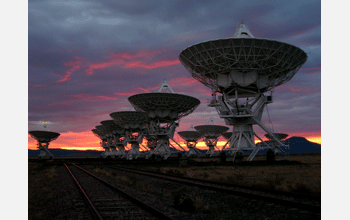Multimedia Gallery
VLA at Sunrise
The Very Large Array (VLA) radio telescope at sunrise.
The VLA is a collection of 27 radio antennas located at the National Radio Astronomy Observatory site in Socorro, N.M. Each antenna in the array measures 25 meters (82 feet) in diameter and weighs about 230 tons. The Y-shaped array can be arranged into four different configurations: A, B, C or D, depending on the distance between the antennas. The VLA is an interferometer, which means that the data from each antenna can be combined electronically so that the array effectively functions as one giant antenna. Dedicated in 1980, the VLA is used by astronomers from around the world to study everything from black holes to planetary nebulae. For more information, please visit the VLA website.
More about this Image
Astronomers recently used the National Science Foundation's Very Large Array (VLA) radio telescope (above) to help find the most distant water yet seen in the universe, in a galaxy more than 11 billion light-years from Earth. Previously, the most distant water had been seen in a galaxy less than 7 billion light-years from Earth. The soggy galaxy is dubbed MG J0414+0534. In a region near its core, water molecules are acting as masers, the radio equivalent of lasers, to amplify radio waves at a specific frequency.
The water molecules showed themselves with a tell-tale radio "fingerprint." The first indication came from the giant, 100-meter-diameter radio telescope in Effelsberg, Germany, and scientists confirmed the discovery using the VLA. The astronomers say their finding indicates that such giant water masers were more common in the early universe than they are today. MG J0414+0534 is seen as it was when the universe was roughly one-sixth of its current age.
At the galaxy's great distance, even the strengthening of the radio waves by the masers would not by itself have made them strong enough to detect with the radio telescopes. However, the scientists got help from nature in the form of another galaxy, nearly 8 billion light years away, located directly in the line of sight from MG J0414+0534 to Earth. That foreground galaxy's gravity served as a lens to further brighten the more distant galaxy and make the emission from the water molecules visible to the radio telescopes.
"We were only able to discover this distant water with the help of the gravitational lens," said Violette Impellizzeri, an astronomer with the Max-Planck Institute for Radio Astronomy (MPIfR) in Bonn, Germany.
Water masers have been found in numerous galaxies at closer distances. Typically, they are thought to arise in disks of molecules closely orbiting a super-massive black hole at the galaxy's core. The amplified radio emission is more often observed when the orbiting disk is seen nearly edge-on. However, the astronomers said MG J0414+0534 is oriented with the disk almost face-on as seen from Earth.
"This may mean that the water molecules in the masers we're seeing are not in the disk, but in the superfast jets of material being ejected by the gravitational power of the black hole," explained John McKean, also of MPIfR. [Story written for LiveScience by Dave Finley, NRAO/AUI/NSF] (Date of Image: 2008)
Credit: Dave Finley, NRAO/AUI/NSF
See other images like this on your iPhone or iPad download NSF Science Zone on the Apple App Store.
Images and other media in the National Science Foundation Multimedia Gallery are available for use in print and electronic material by NSF employees, members of the media, university staff, teachers and the general public. All media in the gallery are intended for personal, educational and nonprofit/non-commercial use only.
Images credited to the National Science Foundation, a federal agency, are in the public domain. The images were created by employees of the United States Government as part of their official duties or prepared by contractors as "works for hire" for NSF. You may freely use NSF-credited images and, at your discretion, credit NSF with a "Courtesy: National Science Foundation" notation.
Additional information about general usage can be found in Conditions.
Also Available:
Download the high-resolution JPG version of the image. (2.5 MB)
Use your mouse to right-click (Mac users may need to Ctrl-click) the link above and choose the option that will save the file or target to your computer.

